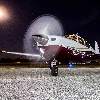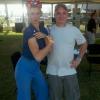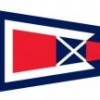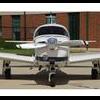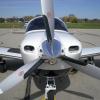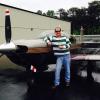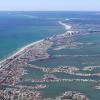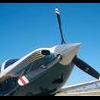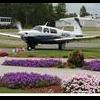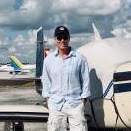Leaderboard
Popular Content
Showing content with the highest reputation on 07/22/2015 in all areas
-
4 points
-
I'm not one to rush to judgment and condemn others. I will wait for the NTSB to figure it out. One thing I've learned after 6000 hours of Mooney flying is that I'm completely capable of just about every bone head mistake that can be made. I'm not saying that I'm a bad pilot, I think I'm a very good pilot, but if you fly enough some day somewhere something will happen. None of us on here can walk on water, we all make mistakes. Condemning other peoples mistakes does no good. All we can do is look at the facts and strive not to make then ourselves!4 points
-
The serious problemn with newer airplanes is useful load. fill her up and 200 lbs in the cabin. Same as a Mite. The new A36 isnt much better in this regard, we sat in a new one at OSH last year and it was 950 lbs. Same as my 201. 165 knots. About the same as my 201. Shoulder room, about the same as my 201. GPH, 14-16, (substantially more). Price tag, 675K. ten times what I bought my plane for. But I do envy those big doors.3 points
-
3 points
-
Actually it's the opposite, the old dead disks are like an under inflated basketball where the new disks will have more rebound. In my case the AP said the undercarriage wasn't fully closing and that was due to the 18 year old disks, so they can be considered a speed mod [emoji1]2 points
-
At the risk of eliciting the inevitable response that people were dying when spins were required training, I will state my view that I think spin training should be required. I got in an inadvertent spin early in PPL training, and I froze. Being told how to recover, and actually doing it the first time the world is spinning around you are two different things. I took the CFI spin course before finishing my PPL and it made me more confident and competent. The training also involved a healthy dose of aerobatics, which helps you learn energy management and a better understanding of the fight envelope. One aspect of the training that I found particularly enlightening was doing cross controlled stall entries and recoveries. These are a real killer, and I think doing them gives you a real appreciation of the risks of getting too slow in the pattern, particularly base to final. I do think this training should be done in an aerobatic aircraft with a qualified aerobatic instructor. I did my training with an airshow pilot and have gone back periodically for the fun of it and to refresh my skills. I would never do these maneuvers in my Mooney, however.2 points
-
This is no doubt a poor spot to make the suggestion, but perhaps a category devoted to the fly-to-meal would be appropriate for MooneySpace. I'm a foodie and, I must admit, I watch some of the "Best Eats" TV shows for ideas about someday airplane destinations for little more than an excuse to fly and eat. Some mission, eh? The bulk of my flying is already devoted to the dual pleasure of flight and gurgitation and I monitor Fly2Lunch, Tripadvisor, etc. for potential destinations already. As MS is the only aviation forum I bother with, I'd enthusiastically follow recommendations of the forum for gastronomic satiety wherever it exists.2 points
-
The nice thing about something mechanical is that it tends to show up as faulty very quickly if improperly designed or installed. In my race car days, races were won and lost in the shop, as I imagine they still are. Airplane construction is really no different. The fast build completion centers that a lot of the kit makers are leaning towards provide a standardization of construction and I would think best practices to help insure the quality and thus safety of the human element. Some of the RV's I have seen rival the craftsmanship of Indy cars, only to find they have been built by guys who build indy cars They make some of the certified planes look like a rather poorly thought out example using technology of yesteryear. Proven technology? For the most part, but We have proven we can wear out a cam in a Lycoming engine for sure, and we can make junk out of a pair of magnetos in 500 or so hours, along with vacuum pumps and a host of other somewhat critical certified parts. Flap motors that cost 2K used, no back clutch springs if available costing well north of 1K, Mixture cable at $500, E model induction boot at $400, shock donuts at 130 ea., there is some real insanity to the certified world pricing. But I digress, the real weak link in the accident chain is still the system we are most reluctant to look at...ourselves. Us doing what we do best sometimes isn't good enough. We are a complex component of a flight system that has a lot of potential of needing service regularly.2 points
-
The other place, Cri**r was worse, but in different categories. The paint, for one thing, looked horrible. Touvh ups all over and fuzzy stripes, overspray around rivets. Controls not taken off. They dont have a paint booth, they hang plastic and paint in thr corner. Overspray. Dry spray, runs, solvent pop, buffed wings with little white specs of touch up paint that dont match where the rivets were buffed to metal. paint on everything, hinges, rod ends, tires, door jambs, props, baffles, alternator belts. If it were free I would be pissed. Then there are the 17K paint shops. They look good. Then there are the 17K paint shops that rent as good. Then theres the 9K paint shops that look like crap. Then theres Hawk, which is ~9k priced and looks really good, perhaps 90% as good as the Tejas or Murmer which are the highest priced out there.1 point
-
I would fly down to VDF and have Joe at Hawk Aircraft Painting do your paint job. You can see my photo gallery. Ask him to use the "mask" that he can order from a guy he knows. Makes the paint job super precise http://mooneyspace.com/gallery/album/13633-n252bh-paint/1 point
-
I would have preferred a factory built plane too back when they didn't cost twice as much as my house.1 point
-
Re-screening of the airspeed indicator and new POH paperwork was what was required when I did this to my 1990 M20J-AT. Quite a nice upgrade. Watch density altitude at the higher weight and plan departures accordingly.1 point
-
His serial number is 3126. Looks like he is golden. Thanks for the quick response. Sent from my iPad using Tapatalk1 point
-
Well, I'm curious again and refreshing my memory. Hopefully his S/N is between 1686 and 3200. Here is the TC link: http://rgl.faa.gov/Regulatory_and_Guidance_Library/rgMakeModel.nsf/0/cd54a24fc81bae1c86257df20054b12c/$FILE/2A3_Rev_56.pdf Search down to M20J section and you'll find this: S/N 24-3201, 24-3218 thru 24-TBA, and 24-1686 thru 24-3200, 24-3202 thru 24-3217 when c/w MAC dwg. No. 940071 and insertion of applicable AFM supplement - 2900 lbs. gross weight. C.G. Range (+45.0) to (+50.1) at 2900 lbs. (Landing gear extended) (+43.8) to (+50.1) at 2740 lbs. (+41.8) to (+50.1) at 2470 lbs. (+41.0) to (+50.1) at 2250 lbs. or less (Straight line variation between points given). Retraction moment 615 in. -lbs. I don't remember what is in the DWG #940071 but it isn't much. Doing the Encore conversion on a 252 (+230 lb GW) changes significant hardware.1 point
-
Most airplanes unless you hold the wheel back will progress rapidly from a spin (an arobatic maneuver where air speed will hover at stall speed) to a spiral where airspeed rapidly increases. Spins are fun, spirals not so much. Never spun a Mooney and have no intention, sort of the same way I have never spun a twin. Some planes just aren't meant for it and recovery is often more luck than anything else. If you want to do spin training do it in a plane meant for it. Also keep in mind that unless you are doing a spin with a CFI for the purpose of a CFI rating and you have a passenger you need chutes technically.1 point
-
Search for this thread: Gross Weight Increase STC for J's Started by Jeff_S , Jan 06 2010 02:56 PM1 point
-
I might have just answered his question on the email list. You'll have to go to the TC data on the FAA website and make sure his S/N is in the eligible range. I believe it points to a Mooney drawing for compliance, and it might just be a re-screen of the airspeed indicator and maybe POH revision. Any MSC should be able to do it if the plane is eligible, and it shouldn't be crazy money.1 point
-
I went through much of the same debate before painting mine. I went for a custom modern paint scheme and colors vs. similarly awful factory '77 colors that were on mine. Many of us used a great freelance scheme design guy with a great eye for Mooneys, but unfortunately he passed away last fall. I'm not a huge fan of the Scheme Designers outfit you might have seen in AOPA, but some of their work on Mooneys is nice. You'll want to find a shop relatively close to you for potential warranty work. Ask for customer references from many years ago, and see if you can put your own eyes on their work. I emphasize looking at 3+ year old paint jobs because you'll really see how they're holding up. I get more disappointed with my paint job quality every time I clean the plane and find more flaws. A few folks here have used Hawk in FL with much success. Otherwise I don't know much about what is available on the east coast. You'll likely use Jet Glo and Acry Glo paint products. You'll of course want a full chemical strip, alodine, etc. and not just a scuff 'n paint. Any corrosion should be found and mitigated during this process. The 1-pc belly is an expensive conversion and adds some measurable weight unless you go with the carbon fiber version developed by Bill Wheat and Dugosh in Kerrville. I'm not sure if it is still available, though. I opted to skip it and put money towards more important upgrades. You won't find a salvage 1 pc belly in usable condition. You might find someone selling one second-hand/never installed, but they're rare. You can always add it later if you wish and just get a local painter to spray the belly...it will likely be a solid color anyway and easy to do off the plane. Factory wingtips will require new ailerons and counterweights and that is really, really expensive. Even used ailerons will be expensive. I'd save the money again for something more meaningful unless your ailerons are already hail damaged or twisted or otherwise not tip-top. Definitely change your windscreen, and carefully decide if that new windscreen will make the side windows suddenly look old. The windows are relatively cheap and you might just do all of them if they've never been changed. You'll be happy with new ones and a modern grey tint if you choose vs. older green shades. Thicker means more weight and less useful load. Modern ANR headsets do far better than thicker windows in protecting your hearing. Thicker windscreen is marginally more resistant to a bird strike, but also harder to install and get the front fairing to accommodate. You might want to get a local mechanic to change all of the glass before delivery to a paint shop. Not all shops are good with mechanical work. If your tanks are leaky, or have never been re-sealed, you might STRONGLY consider getting them stripped and sealed prior to paint since that operation can locally damage paint when the panels are removed. Changing an N-number is personal and requires some FAA hoop-jumping. Personally I think it is bad juju to change her name after so long. You might consider swapping the lower gear doors to the newer composite & lower profile doors prior to paint. The brake calipers get moved to the front of the wheel, and the blister/bump fairing gets removed in the process. The composite doors sit much closer to the wing and are much more durable than the OEM metal assemblies. Check your nose gear doors for wear/erosion as well and consider changing to the newer overlapping style if they're worn. I kinda wish I would have removed the gear and really done a nice clean/strip/paint operation on separate components vs. just spraying EVERYTHING while it was installed. This would be a LOT more work and require a shop with some Mooney familiarity to get it done right, but it is rare to find anyone that removes gear for painting. I would inspect the shop for cleanliness and talk to as many customers as I could find. I would also recommend getting the shop to put fuel sealant or similar in a skinny bead around the windscreen and perhaps all windows to prevent paint edge erosion. It is a nice detail that looks fine and will help the paint last a long time. If the shop isn't familiar with Mooneys, have them trim the tail to the takeoff position before masking the stripes so everything will line up nicely on the ground. (and then you must remember to re-trim to takeoff after landing, before parking. )1 point
-
Very sad. One reason why I don't fly into KOSH for the show any more.. too many things out of my control. Used to all the time, but no more. Seen too many accidents and planes torn up for no good reason. Now I fly into KGRB. Much safer for me and my plane. And I enjoy the show just as much. Best wishes and prayers for all on board.1 point
-
I also think they elimated the movable cowl flaps and they became fixed.1 point
-
I believe all of the airplanes had some flush rivets on the wing. The later models had less. The 60s aircraft did not have 100% flush rivets on the wings, as you get closer to the trailing edge, they have no effect on drag anyway. Most people who beef with the quadrant likely do so because it is an in efficient use of space in a cockpit that is not known for having a surplus. The fuselage on the early birds was treated Zinc Chromate, Not sure about the 70s birds. Smooth tail surfaces. The rudder and elevator on the early birds was smooth on the out side with internal stiffeners, the later birds had "stamped" rudders and elevators. The few Fs that were made in 66 and all of the Fs made in 67 had 2 piece windshields The few Fs that were made in 66 and all of the Fs made in 67 had a "twist" wing design. I believe this design was intended to maintain aileron control through the stall by gradually shallowing the angle of incidence towards the tip. The result was supposed to be a wing the stalled at the root first and gently worked it's way outward. My 67F stalls pretty benignly, but almost always falls off to the left. I've never tried to pick it up with aileron and never will. Shotgun panel, most have been upgraded. Retractable wing step. Maybe saves a few knots, very simply engineered. Ours has performed flawlessly since 1967. Beautiful design. Saving the best for last. Manual Gear and hydraulic flaps! These 2 systems are without question in my opinion the finest systems I have ever come across in any 4 place GA airplane. They best almost any comparable system in terms of weight, simplicity, reliability and durability. It will take about 10 to 20 take offs and landings to get comfortable with them, then it becomes very natural. These systems possess a particular tactility that is unique among GA aircraft. Aircraft often feel under built if not a bit flimsy in areas. The knurled chrome Johnson Bar feels as robust as an 8lb sledge. It moves about a very precise arc and gives a very positive click as it locks into it's socket. Same with the flaps - no wasted motion. The handle is smoothly finished chrome. Each input translates into an exact output at the flaps. I have mine perfectly set up to deliver full flaps at precisely 4 pumps, there is no wasted motion. OK, I'm done romanticizing... go ahead and flame!1 point
-
1 point
-
No deals really this year that I've found, not like the good old days. Coolest new thing I've seen so far was from Sandia for those of us who don't have all our eggs in the Garmin basket. http://sandia.aero/product/stx-360-sentinel/1 point
-
1 point
-
Thanks guys for all of the comments and questions. I've researched the ram air on the E & F models and talked with some very knowledgeable Mooney folks and the consensus is that by moving the filtered air into the left cylinder air inlet, the same boost to mp can be achieved. if I do this, I can use most of the same parts except for the air inlet for the fuel injection on the 66 C, E, F & G models. This will keep the costs down if I can do this under one STC. It will do away with all the ram air rubber seals and the air filter on the above models and make them more in line with the J model. I'd like to find an option for the spinner, but if it's not already certified and fits certain dimensions, it can add 100 hours of test flights to get it certified as part of the STC. That would delay the project and raise costs, so it's a matter of where's a good balance in the cost vs benefit in the project. It was great meeting and talking with Ned, Clarence, Yves, Andy, Johnathon, Vincent and many more. Thanks again, David1 point
-
Simple test for replacement is to jack the aircraft and without waiting too long, 5 minutes or so maximum, grasp the donuts and try to rotate them in place. If they are loose or can be moved (rotated) even a little, they should be replaced.1 point
-
That could be problem--- I'm 6'1" 205 lbs. With one or two of Marauder's broads aboard it would be a taxi only proposition!1 point
-
1 point
-
I'm not looking to place blame and I certainly don't expect ATC to monitor and try to anticipate every VFR but what I'm thinking and I know that in all fields when someone has a high level of experience you can start to put things together that raises your level of concern and in a situation when you see 2 aircraft converging it might be possible to make contact with the unknown traffic. As a VFR only pilot I try to get flight following when ever I leave my very very low traffic area. One of my short routes that I take puts me over 2 class D ports and if I did not get FF I will monitor tower frequency for each area I pass over incase I am that unknown traffic. Anyway if I hear control advising and I know it's me as the unknown I can speak up identify and comply if needed1 point
-
1 point
-
With the announcement you sent me Mike, maybe this has changed. I am still going to wait this stuff out. Too much time and too much money at stake... I get the FlightStream unlock thing. Aspen is buying the FlightStream product probably under some sort of OEM agreement and they probably wrote the lockout in the contract to protect from competing against FlightStream. If the L3 and Aspen deal is truly a collaboration, maybe this lockout fee doesn't exist anymore. L3 doesn't need Aspen... It has its own display (yeah, it's small) and can display traffic and weather without the Aspen. I would like to see it show up on the Garmin, but hell is still pretty warm for it to freeze over... Sent from my iPad using Tapatalk1 point
-
Fear can change you... I remember being on a bike ride going down a hill going way faster than I should have been (50 mph). It was dusk and at the bottom there was a bend and a stone wall. I panicked and locked the brakes. For an instant I thought I was done for, but ironically something I learned as a pilot kicked in. There was an old time pilot who told me once that "if bad sh$t happens while you are flying, undo the last thing you did". So, I let go of the brakes, the tires grabbed and I steered away from the wall. Some fight to the end, others end the fight and succumb... Sent from my iPad using Tapatalk1 point
-
This is the general info email on their web site. info@skyvector.com Also here is his direct email as well. Just be polite and to the point as I know all MS people can be. dgraves@skyvector.com1 point
-
Years ago when I was young and foolish, an Air Force buddy and I climbed to 10,000 ft to test the stall/spin characteristics of a new M20J. Landing configuration, low power setting, nose up, hold it until typical docile stall, then nose up more, until spin entry. Gentile entry, fall off to the left (the stalled wing), and down we go. Being a Mooney is was smooth. Let it go around once, lost almost 1,000 ft. IIRC then fast PARE corrections. Went around another one and a half times, lost another 1,500 ft., to a smooth Mooney recovery. Remember, this was two current Air Force fighter pilots. Neither one of us has tried it again in a Mooney. Not for weekend pilots, never for timid flyers, and most assuredly not safer with some curious CFI. They don't have a good record. Remember, you can stall/spin from any attitude and speed. One reason an AOA is a much better investment, IMO, than that third or forth GPS. In conclusion stay far away from stall/spins in your Mooney, and if everything turns to $hit, panic is your enemy, fly that plane until you've stopped. Fly safe out there.1 point
-
Mike's comments are spot-on, and I can only ad that if/when you decide to sell a plane with damage history, the pool of potential buyers is smaller. Of course you bought it on a discount, and you'll have to sell it on a discount as well. The good news is that the stigma of damage history fades with time, and 10 years/hundreds of hours of post-damage use is a good vote of confidence. I'd be more concerned with corrosion vs. correctly-repaired damage. The 252 is great, and will have the 2+2 seat configuration that is wonderful. If you run out of useful load, you can do an Encore conversion for relatively modest money to get +10 HP and +230 lb gross weight.1 point
-
Thanks for sharing. As I am sure you are aware, the reason one enters a spin is because of an uncoordinated stall. It sounds like this happened while at the bottom edge of the envelope. P factor will cause the left wing to drop if you do not have enough right rudder in the slow flight regime, something I have noticed Mooney pilots tend to get relaxed about because of the interconnected ailerons and rudder. Some tail dragger time will fix this. Another dangerous time is on a balked or bounced landing go around. You are 8 feet up after a bounce and decide to firewall it and go around. You better have some right rudder in it or you may prang the left wing and cartwheel, ending UFOW. This is especially true with the O3's and other fire breathing high horse Mooneys. Great job of recovery and doing what is needed.1 point
-
The question is more what is the plane worth to you? If it is already priced as if it had major damage history, and you know it has been repaired properly, verified by 10 years of continuous duty afterwards, It is no longer a question of how much deduction for prior history, but what is the plane worth to you. Would you pass on this one to find a similar one without the damage history for considerably more? if so, then pass. If this one already is low enough priced (typically what attracts one in the first place) is the price low enough to compensate for the correctly repaired damage? Your call..not ours Good luck in finding your perfect mistress!1 point
-
PARE: P=Power - Off. A=Ailerons - Neutral (& flaps up). R=Rudder - Full Opposite, quickly. E=Elevator - Briskly Through Neutral. Hold these inputs until rotation stops, which can be two or three rotations and several thousand feet in a Mooney, then: Rudder - Neutral. Elevator - Recover to Straight and Level. Upon landing, kiss ground and change underwear.1 point
-
An hour out, an hour back. Two hours' flight at 9 gph is 18 gals. Last fuel I bought was $4.02, costing $72.36 in gas and maybe $1.50-$2.00 in oil. That leaves > $25 for food, easy to do for burger or barbecue, since I can only drink tea if I'm flying home. This flight carries no incremental costs for insurance, hangar, Garmin updates, etc., as they would be paid whether I fly to lunch or not. So yes, the $100 burger does still exist here in Alabama. YMMV. It works for me!1 point
-
I agree. I just want to do what I do best and let others do what they do best. I'll trust the pros to build them and I'll stick to flying them!1 point
-
I know that the local Air national guard would regularly beat regular air force pilots head to head with F-4s versus the newer F15s. Not decades apart in design but it was impressive. Of course the guard pilots were all Vietnam vets who flew for their life against enemy fire. I guess when in hat situation you learn to fly a little differently than just training. An F-16 in the right hands I believe can beat an F35 for sure. I'm sure an F-15 could as well.1 point
-
Dear Two-Bags - I mean Fantom. POST OF THE YEAR! Not even close - no other post comes even close. You are hereby the funniest man with a Mooney in the world. How did you end up getting this ride? How did you get this invite? I hear you and I officially stick my fingers in my ears - I'd ride with Biff, or (up)Chuck or whatever Military Aviator will take me in whatever Fxx they have the keys too. Take me along too!1 point
-
Wow. What blatant disregard for an emergency situation! Each and every drone operator that is found to be in willful violation of the obvious TFR should be prosecuted just as any manned aircraft's pilot would be. Ignorance of the law is no excuse.1 point
-
<<<Someday you may be invited to fly in the back-seat of one of our country's most powerful fighter jets. Many of you already have. John Elway, John Stockton, Tiger Woods to name a few. If you get this opportunity, let me urge you, with the greatest sincerity... Move to Guam . Change your name. Fake your own death! Whatever you do. Do Not Go!!! I know. The U.S. Navy invited me to try it. I was thrilled. I was pumped. I was toast! I should have known when they told me my pilot would be Chip (Biff) King of Fighter Squadron 213 at Naval Air Station Oceana in Virginia Beach . Whatever you're thinking a Top Gun named Chip (Biff) King looks like, triple it. He's about six-foot, tan, ice-blue eyes, wavy surfer hair, finger-crippling handshake -- the kind of man who wrestles dyspeptic alligators in his leisure time. If you see this man, run the other way, Fast. Biff King was born to fly. His father, Jack King, was for years the voice of NASA missions. ('T-minus 15 seconds and counting .' Remember?) Chip would charge neighborhood kids a quarter each to hear his dad. Jack would wake up from naps surrounded by nine-year-olds waiting for him to say, 'We have liftoff'. Biff was to fly me in an F- 14D Tomcat, a ridiculously powerful $60 million weapon with nearly as much thrust as weight, not unlike Colin Montgomerie. I was worried about getting airsick, so the night before the flight I asked Biff if there was something I should eat the next morning. 'Bananas,' he said. 'For the potassium?' I asked. 'No,' Biff said, 'because they taste about the same coming up as they do going down.' The next morning, out on the tarmac, I had on my flight suit with my name sewn over the left breast. (No call sign -- like Crash or Sticky or Leadfoot. But, still, very cool.) I carried my helmet in the crook of my arm, as Biff had instructed. If ever in my life I had a chance to nail Nicole Kidman, this was it. A fighter pilot named Psycho gave me a safety briefing and then fastened me into my ejection seat, which, when employed, would 'egress' me out of the plane at such a velocity that I would be immediately knocked unconscious. Just as I was thinking about aborting the flight, the canopy closed over me, and Biff gave the ground crew a thumbs-up. In minutes we were firing nose up at 600 mph. We leveled out and then canopy-rolled over another F-14.. Those 20 minutes were the rush of my life. Unfortunately, the ride lasted 80.. It was like being on the roller coaster at Six Flags Over Hell. Only without rails. We did barrel rolls, snap rolls, loops, yanks and banks. We dived, rose and dived again, sometimes with a vertical velocity of 10,000 feet per minute. We chased another F-14, and it chased us. We broke the speed of sound. Sea was sky and sky was sea. Flying at 200 feet we did 90-degree turns at 550 mph, creating a G force of 6.5, which is to say I felt as if 6.5 times my body weight was smashing against me, thereby approximating life as Colin Montgomerie. And I egressed the bananas. And I egressed the pizza from the night before. And the lunch before that. I egressed a box of Milk Duds from the sixth grade. I made Linda Blair look polite. Because of the G's, I was egressing stuff that I never thought would be egressed. I went through not one airsick bag, but two. Biff said I passed out. Twice. I was coated in sweat. At one point, as we were coming in upside down in a banked curve on a mock bombing target and the G's were flattening me like a tortilla and I was in and out of consciousness, I realized I was the first person in history to throw down. I used to know 'cool'. Cool was Elway throwing a touchdown pass, or Norman making a five-iron bite. But now I really know 'cool'. Cool is guys like Biff, men with cast-iron stomachs and freon nerves. I wouldn't go up there again for Derek Jeter's black book, but I'm glad Biff does every day, and for less a year than a rookie reliever makes in a home stand. A week later, when the spins finally stopped, Biff called. He said he and the fighters had the perfect call sign for me. Said he'd send it on a patch for my flight suit. What is it?? I asked. 'Two Bags.'>>>1 point
-
I know if I was about to do something stupid or if I just was unaware of a condition that could prove dangerous I know I would appreciate it being pointed out no matter what the experience level of he observer.1 point
-
Relax, Ross, he's quoting Bill Engvall. He just left out the "Heeeere's your sign" part.1 point
-
1 point
-
1 point



